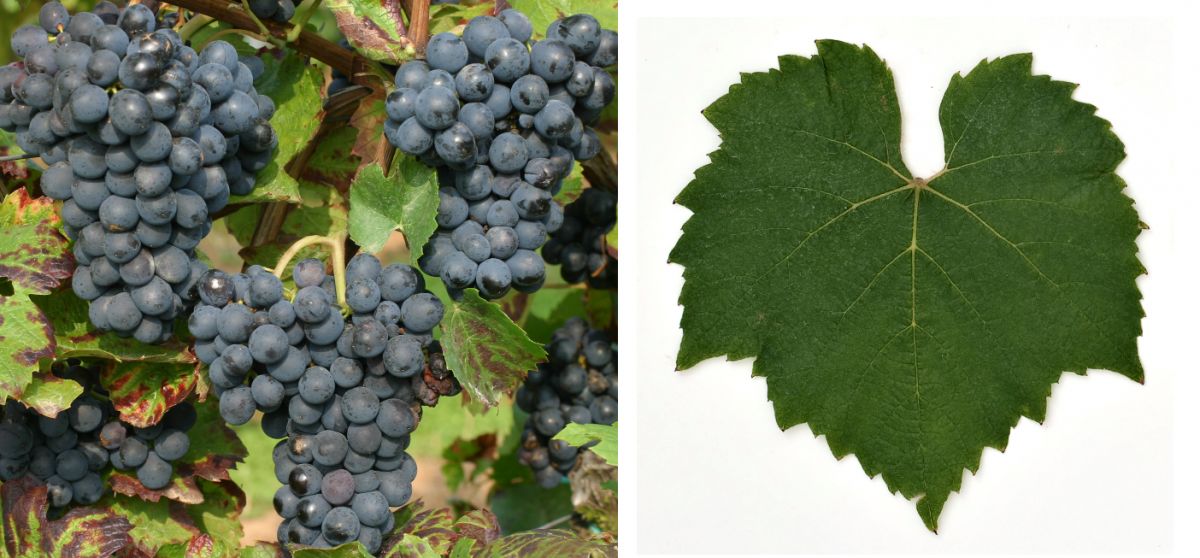The red grape variety originates from France. The full name is Gamay Noir à Jus Blanc due to its almost white flesh, to distinguish it from red-fleshed Gamay varieties. There are around 150 synonyms, testifying to its widespread distribution and presumably great age. Some of them are Beaujolais, Bourguignon Noir, Caracairone, Gamai, Gamai Chatillon, Gamay Beaujolais, Gamay Charmont, Gamay d'Arcenant, Gamay d'Auvergne, Gamay de la Dôle, Gamay de Liverdun, Gamay de Saint-Romain, Gamay de Sainte-Foix, Gamay de Toul, Gamay de Vaux, Gamay d'Orléans, Gamay du Gâtinais, Gamay Labronde, Gamay Noir, Gamay Ovoïde, Gamay Précoce, Gamé, Gammé, Grosse Dôle, Liverdun Grand, Lyonnais, Melon Noir, Petit Bourguignon, Petit Gamay, Plant Robert (independent clone), Black Melon Grape. It should not be confused with the Abouriou, Avanà, Blaufränkisch, Gascon, Gouget Noir, Grolleau Noir, Pinot Noir, Troyen or Valdiguié varieties, despite the synonyms or morphological similarities that seem to indicate it.

According to one hypothesis, it is said to have come to France from Dalmatia under the Roman Emperor Probus (232-282). However, it probably originates from Burgundy and is possibly named after the commune of Gamay near Saint-Aubin in the Côte d'Or. The very old variety was first mentioned in 1395 in an excommunication by Duke Philip II the Bold (1342-1404). It speaks of a very bad variety Gaamez, from which abundant quantities of wine spring, which is terribly bitter and the people are afflicted by serious diseases. Therefore, it was ordered that the vines be destroyed or no longer planted throughout the country. This official ban was reaffirmed several times until the middle of the 18th century and has given rise to the rather bad reputation of this grape variety until recent times.
DNA analyses carried out by Dr. Carole P. Meredith and J. E. Bowers (University of California), as well as Jean-Michel Boursiquot (Montpellier) in 1999 clarified the variety's ancestry. It is one of the many natural crosses between the two leading varieties Pinot x Gouais Blanc (Heunisch). The variety was a crossing partner of the new varieties Aris, AZ 15477, Florental, Galotta, Gamaret, Garanoir, Mara and Oberlin Noir, as well as a parent of Meslier Noir. There are other grape varieties with the name part Gamay. With four exceptions, however, there are no genetic relationships:
- Gamay 15 (Napa Gamay) = Valdiguié
- Gamay Beaujolais = Abouriou, Gamay, Pinot Noir
- Gamay Blanc = Chardonnay, Melon de Bourgogne, Plantscher, Silvaner
- Gamay Blanc Gloriod(Gouais Blanc x Pinot) - white sibling variety of Gamay
- Gamay de Châtillon (Gamay Groslot) = Grolleau Noir
- Gamay de Rolampont, Petit Gamay = Troyen
- Gamay d'Orléans = Gascon
- Gamay d'Orléans Pour Pulliat (Gamay à Grains Rond, Gamay d'Abondance) = Abondance
- Gamay du Rhône (Gamay Saint Laurent, Gamay Beaujolais) = Abouriou
- Gamay Goutot = Jurançon Noir
- Gamay Luverdon = Canari Noir
- Gamay Perugino = Garnacha Tinta
- Gamay Précoce = even earlier ripening mutation of Gamay
- Gamay Teinturier de Bouze = mutation Gamay or descendant Teinturier du Cher
- Gamay Teinturier de Chaudenay = mutation Gamay Teinturier de Bouze
- Gamay Teinturier Fréaux = Mutation Gamay
- Gamé = Blaufränkisch
This early-maturing vine is relatively sensitive and susceptible to botrytis, grape berry moth, black spot disease and brushwood disease. It produces refreshing, low-alcohol and low-tannin red wines with aromas of raspberries and cherries. As a rule, these should be enjoyed young. The wines produced by carbonic maceration as extremely early drinking Beaujolais Nouveau are often pale and thin. In contrast, wines aged in barriques achieve very good quality and, in the Beaujolais Crus, a certain longevity. The variety is widespread in France and is permitted in many appellations in almost all regions except Bordeaux, Alsace and Corsica. In Beaujolais, it occupies around 90% of the vineyard area with almost 20,000 hectares. The production of this red wine is precisely matched to the varietal characteristics, which is why the vine is also aptly called the "Beaujolais grape". In Burgundy, it is blended with Pinot Noir to produce Passe-Tout-Grain ( Gemischter Satz). In the Loire, it is represented with around 5,000 hectares and the same quantity in the rest of France. The French cultivated area totals 24,095 hectares with a downward trend.
In Switzerland, Gamay is the third most common variety with 1,349 hectares. Here it is blended with Pinot Noir to make the branded wine Dôle. A special clone exists in the canton of Vaud under the name Plant Robert. There were further stocks in the European countries England, Italy (64 ha), Luxembourg, Portugal (0.1 ha), Serbia (54 ha), Slovenia (4 ha), Turkey (228 ha) and Hungary (3 ha). Overseas, there are cultivated areas in Argentina (0.4 ha), Australia (6 ha). Brazil (5 ha), Chile (0.5 ha), Canada (272 ha), New Zealand (7 ha), South Africa (9 ha) and Uruguay (1 ha), and in the USAä in the states of California, Michigan, New York, Oregon and Texas (123 ha). In 2016, a total of 26,221 hectares of vineyards were reported, with a downward trend. It is thus in 34th place in the global grape variety ranking (Kym Anderson).
Source: Wine Grapes / J. Robinson, J. Harding, J. Vouillamoz / Penguin Books Ltd. 2012.
Images: Ursula Brühl, Doris Schneider, Julius Kühn-Institut (JKI)
Voices of our members

wein.plus is a handy, efficient guide to a quick overview of the colourful world of wines, winegrowers and grape varieties. In Wine lexicon, the most comprehensive of its kind in the world, you will find around 26,000 keywords on the subject of grape varieties, wineries, wine-growing regions and much more.
Roman Horvath MW
Domäne Wachau (Wachau)